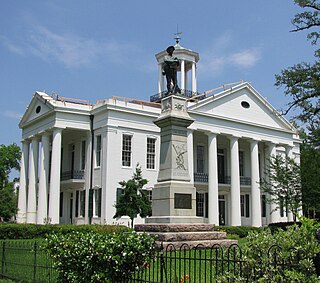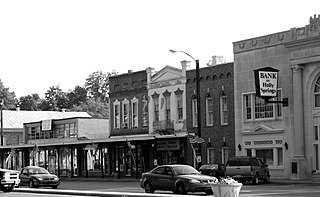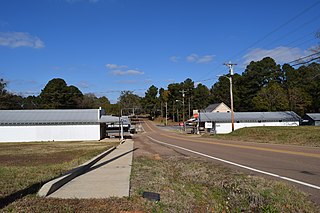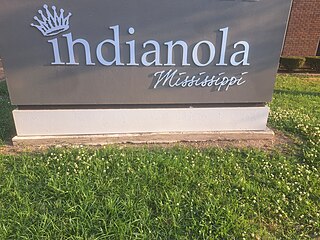
Lafayette County is a county in the U.S. state of Mississippi. At the 2020 census, the population was 55,813. Its county seat is Oxford. The local pronunciation of the name is "la-FAY-et." The county's name honors Marquis de Lafayette, a French military hero and American general who fought during the American Revolutionary War.

Hinds County is a county located in the U.S. state of Mississippi. With its county seats, Hinds is the most populous county in Mississippi with a 2020 census population of 227,742 residents. Hinds County is a central part of the Jackson metropolitan statistical area. It is a professional, educational, business and industrial hub in the state. It is bordered on the northwest by the Big Black River and on the east by the Pearl River. It is one county width away from the Yazoo River and the southern border of the Mississippi Delta.

Oxford is a city in and the county seat of Lafayette County, Mississippi, United States. Oxford lies 75 miles (121 km) south-southeast of Memphis, Tennessee. A college town, the University of Mississippi or "Ole Miss" is located adjacent to the city. Founded in 1837, it is named for Oxford, England.

Holly Springs is a city in, and the county seat of, Marshall County, Mississippi, United States, near the border with Tennessee to the north. Along with the Mississippi Delta, in the 19th century, the area was developed by European Americans for cotton plantations. After the Civil War, many freedmen continued to work in agriculture as sharecroppers and tenant farmers.

Cleveland is a city in Bolivar County, Mississippi, United States. The population was 11,199 as of the 2020 United States Census.

Abbeville is a town in Lafayette County, Mississippi. As of the 2020 census, the population was 372.

Indianola is a city in and the county seat of Sunflower County, Mississippi, United States, in the Mississippi Delta. The population was 10,683 at the 2010 census.

Lafayette Township is a township located in the Skylands Region of Sussex County, in the U.S. state of New Jersey. As of the 2020 United States census, the township's population was 2,358, a decrease of 180 (−7.1%) from the 2010 census count of 2,538, which in turn reflected an increase of 238 (+10.3%) from the 2,300 counted in the 2000 census. The township is crossed by Route 15 and Route 94.

R. L. Burnside was an American blues singer, songwriter and guitarist. He played music for much of his life but received little recognition before the early 1990s. In the latter half of that decade, Burnside recorded and toured with Jon Spencer, garnering crossover appeal and introducing his music to a new fan base in the punk and garage rock scenes.

North Mississippi Allstars is an American blues and southern rock band from Hernando, Mississippi, founded in 1996. The band is currently composed of brothers Luther Dickinson and Cody Dickinson. Their most recent album Set Sail was released in 2022.
Chulahoma is an unincorporated community in Marshall County, Mississippi, United States. It is located in the hill country of northern Mississippi.
Deep Blues: A Musical Pilgrimage to the Crossroads is a British documentary film, released in 1991, and made by music critic and author Robert Palmer and documentary film maker Robert Mugge, in collaboration with David A. Stewart and his brother John J. Stewart. The film provided insight into the location, cast and characteristics of Delta blues and North Mississippi hill country blues. Filming took place in 1990 in Memphis, Tennessee, and various North Mississippi counties. Theatrical release was in 1991 and home video release in the United Kingdom, the next year, as was a soundtrack album. A United States consumer edition came in 2000.
Independence is a census-designated place and unincorporated community in Tate County, Mississippi, United States.
Hill country blues is a regional style of country blues. It is characterized by a strong emphasis on rhythm and percussion, steady guitar riffs, few chord changes, unconventional song structures, and heavy emphasis on the "groove", which has been characterized as the "hypnotic boogie".
Springdale is an unincorporated community in Lafayette County, Mississippi. Springdale is located on the former Illinois Central Railroad. The community was incorporated on February 25, 1875, and disincorporated at an unknown date. A post office operated under the name Spring Dale from 1850 to 1887.
Tula is a census-designated place and unincorporated community in Lafayette County, Mississippi, United States. Tula is located on Mississippi Highway 331 7.5 miles (12.1 km) west-southwest of Toccopola.
Denmark is an unincorporated community in Lafayette County, Mississippi, United States. Denmark is located near Mississippi Highway 6 10.6 miles (17.1 km) east-southeast of Oxford. A post office operated under the name Denmark from 1872 to 1968. In 1900, Denmark had a population of 75.

Cedric O. Burnside is an American electric blues guitarist, drummer, singer and songwriter. He is the son of blues drummer Calvin Jackson and grandson of blues singer, songwriter, and guitarist R. L. Burnside.
R.L. Boyce is an American blues singer, songwriter, and guitarist born and raised in Como, Mississippi, United States.

Come On In is a remix album by Delta blues guitarist R. L. Burnside, released by the label Fat Possum in 1998. Largely produced by Tom Rothrock, the album was a departure for Burnside in that it fuses his blues guitar work with dance and electronic music, incorporating sampling and looping techniques. Burnside was originally skeptical of the idea, but enjoyed the finished product. Although the album's fusion of styles was deemed unusual by critics, it received acclaim from music journalists and showed respectable sales, becoming the best-selling album distributed by Epitaph Records in early 1999. The album's sound was explored by Burnside in his later works.














